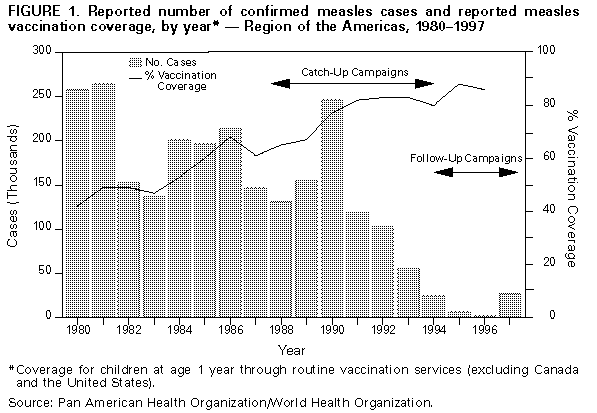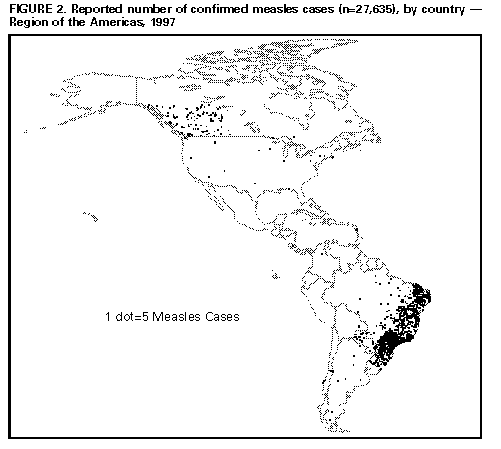 |
|
|
|
|
|
|
| ||||||||||
|
|
|
|
|
|
|
||||
| ||||||||||
|
|
|
|
|
Persons using assistive technology might not be able to fully access information in this file. For assistance, please send e-mail to: mmwrq@cdc.gov. Type 508 Accommodation and the title of the report in the subject line of e-mail. Progress Toward Elimination of Measles from the AmericasIn 1994, the Pan American Health Organization (PAHO) established the goal of eliminating measles from the Western Hemisphere by 2000 (1). To reach this goal, PAHO developed a measles-elimination strategy that includes three vaccination components ("catch-up," "keep-up," and "follow-up" *) and integrated epidemiologic and laboratory surveillance (2-5). The aim of the strategy is to achieve and maintain high levels of measles immunity among infants and children and detect all chains of transmission of measles virus through careful surveillance. This report updates measles surveillance data through February 1998 and summarizes the impact of elimination strategies on measles in the Americas. Each country in the Region of the Americas, except the United States, the French Antilles, and the Netherlands Antilles, conducted measles "catch-up" campaigns during 1987-1994. Vaccination coverage achieved during these campaigns was 94% regionwide, and country-specific coverage ranged from 71% to 99%. In addition, routine measles vaccination coverage among infants increased from 42% in 1980 to 86% in 1996 (Figure_1). In 1996, a total of 27 (57%) of 47 countries and territories achieved greater than 90% coverage, 15 (32%) achieved 80%-90% coverage, and five (11%) achieved less than 80% coverage in their routine vaccination services. Since 1994, a total of 26 (55%) of 47 countries and territories also have conducted "follow-up" vaccination campaigns. The annual number of reported measles cases in the region decreased substantially (Figure_1). In 1996, a record low 2109 confirmed measles cases was reported from the region. Of the 47 countries and territories that provided weekly measles surveillance data to PAHO, 29 (62%) reported no confirmed cases, and 38 (81%) reported less than or equal to 10 cases. Most of the region was free of measles virus circulation during 1996. In 1997, however, a resurgence of measles occurred in the region. Provisional data from January 1997 through February 1998 indicate that 88,485 suspected measles cases were reported from the countries. Of these, 27,635 (31%) have been confirmed, 33,120 (37%) have been discarded, and 27,730 (31%) are under investigation. Of the 27,635 confirmed cases in 1997, a total of 26,919 (97%) were confirmed by laboratory testing or linked epidemiologically to a laboratory-confirmed case, and 716 (3%) were confirmed clinically, without laboratory investigation. Brazil (26,348 confirmed cases) and Canada (570 confirmed cases) accounted for 97% of the total confirmed cases in the region. The United States (135 cases), Paraguay (198), Guadeloupe (116), Argentina (96), Chile (59), Venezuela (27), and Costa Rica (15) all reported greater than 10 confirmed measles cases during 1997. Brazil Of the 26,348 confirmed cases reported from Brazil, 20,186 (77%) were reported from Sao Paulo (Figure_2), the only state that did not conduct a follow-up measles vaccination campaign in 1995. Most cases during this outbreak occurred in persons residing in the greater Sao Paulo metropolitan area. Of the 19,322 confirmed measles cases reported from Sao Paulo for which patient age was known, 9938 (51%) occurred in persons aged 20-29 years. The highest age-specific incidence rates were reported for infants aged less than 1 year (456 cases per 100,000 population), young adults aged 20-29 years (156), and children aged 1-4 years (45). Many cases occurred among young adults who were members of groups congregating in enclosed environments, including male migrant workers from rural areas, students, health-care workers, tourist industry workers, and military recruits. Twenty measles-related deaths were reported; 17 (85%) occurred among infants aged less than 1 year. Genomic sequencing of virus isolates from Brazil, performed by CDC's Respiratory and Enteric Viruses Branch, demonstrated that the virus circulating in Sao Paulo was similar to virus isolates recently obtained from Western Europe, suggesting that the virus responsible for the outbreak may have been imported from Europe. The measles virus circulating in Sao Paulo spread to almost every other state in Brazil. Other Brazilian states reporting large numbers of measles cases included Bahia (1013 cases), Minas Gerais (626), Ceara (594), Rio de Janeiro (577), Parana (462), and the Federal District (432). Other countries in the region documenting spread from Sao Paulo were Argentina, Chile, Costa Rica, Paraguay, Peru, and the United States. Epidemiologic investigation is under way to determine specific risk factors for measles in Sao Paulo. Several factors may have facilitated widespread measles transmission in the greater Sao Paulo metropolitan area in 1997. First, the lack of a timely follow-up vaccination campaign in 1995 for children aged 1-4 years, combined with low routine vaccination coverage among infants, resulted in rapid accumulation of susceptible preschool-aged children. Second, the presence of large numbers of susceptible young adults who had not had natural measles infection or measles vaccination increased the risk for a measles outbreak. Third, measles virus was probably imported from Europe into Sao Paulo. Finally, the high population density of Sao Paulo greatly facilitated contact between infected and susceptible persons (6). Canada During 1997, Canada reported 570 confirmed measles cases. Of these, greater than 300 cases occurred in a university community in British Columbia. Most cases occurred in young adults who had been vaccinated previously with one dose of measles vaccine. Genomic analysis of measles virus obtained from patients during this outbreak suggested that measles virus circulating in British Columbia was imported from Europe. Measles virus from the outbreak in British Columbia spread to the neighboring province of Alberta, where 245 cases were reported; most cases occurred in school-aged children who were vaccinated previously with one dose of measles vaccine. United States During 1997, the United States reported a provisional total of 135 confirmed measles cases. This is the lowest number of cases ever reported and is less than half the previous record low incidence of 309 cases in 1995. During a 7-week period, no indigenous measles cases were reported, suggesting an interruption of measles transmission. Fifty-seven (42%) of the reported cases were documented as international importations, primarily from Europe and Asia. In 1995 and 1996, no documented importations from Latin American or Caribbean countries to the United States were reported. ** In 1997, however, five confirmed imported measles cases were reported from Brazil, all from Sao Paulo. Spread from imported cases was limited, and the largest outbreak in the United States during 1997 comprised eight cases. Reported by: Special Program for Vaccines and Immunization, Pan American Health Organization, Washington, DC. Editorial NoteEditorial Note: Substantial progress has been made toward eliminating measles virus from the Americas. Most countries have implemented PAHO's measles-elimination strategy, and indigenous measles virus circulation has been interrupted in large geographic areas of the region. In addition, improvements have been made in measles surveillance throughout the region, including the development of a regional measles laboratory network with at least one measles reference laboratory in every country. Although the relative resurgence of measles in the Americas during 1997 represented a major increase over the number of cases reported in 1996, these cases still represented only approximately 10% of those reported in 1990. Moreover, the measles cases reported in the Americas in 1996, the last year for which comparable data were available, represented only 0.3% of the total reported global cases (7). Measles case surveillance data, combined with molecular epidemiologic information provided by PAHO's measles laboratory network, suggest the countries of the Americas are constantly challenged by imported measles virus from other regions of the world in which measles remains endemic (8,9). The outbreak in Brazil demonstrates that the absence of measles virus circulation does not indicate the absence of risk for measles outbreaks. This outbreak highlights several major challenges facing the region. First, the countries of the Americas need to achieve and maintain the highest population immunity level possible in infants and children and to supplement existing strategies by targeting measles vaccination to adolescents and young adults at highest risk for exposure to measles virus. Second, surveillance needs to be strengthened to detect population groups susceptible to measles and possible foci of transmission established by measles importations. Finally, increased efforts for control and regional elimination of measles are needed in other regions of the world to decrease the quantity of measles virus exported to the Americas as a step toward global measles eradication (10). References
* Catch-up is defined as a one-time vaccination campaign targeting all children aged 9 months-14 years regardless of history of measles disease or vaccination status; keep-up is defined as routine services aimed at vaccinating greater than 90% of each successive birth cohort; and follow-up is defined as a vaccination campaign conducted at least every 4 years targeting all children aged 1-4 years. ** In 1995, one case that could have been imported from a Latin American country was reported; however, subsequent investigation revealed no evidence of measles transmission in that country. Figure_1  Return to top. Figure_2  Return to top. Disclaimer All MMWR HTML versions of articles are electronic conversions from ASCII text into HTML. This conversion may have resulted in character translation or format errors in the HTML version. Users should not rely on this HTML document, but are referred to the electronic PDF version and/or the original MMWR paper copy for the official text, figures, and tables. An original paper copy of this issue can be obtained from the Superintendent of Documents, U.S. Government Printing Office (GPO), Washington, DC 20402-9371; telephone: (202) 512-1800. Contact GPO for current prices. **Questions or messages regarding errors in formatting should be addressed to mmwrq@cdc.gov.Page converted: 10/05/98 |
|||||||||
This page last reviewed 5/2/01
|